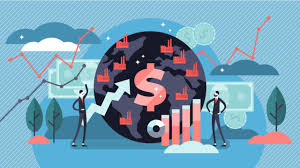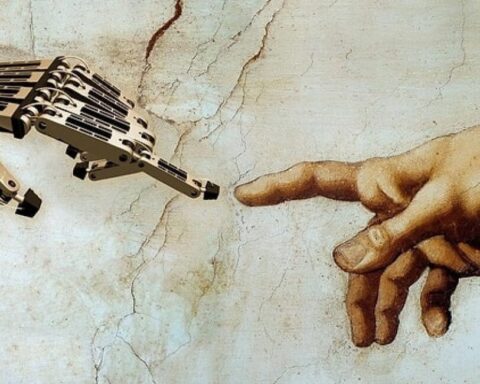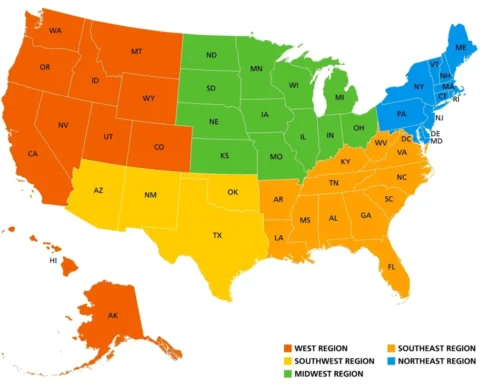The term “economy” is often used as a catch-all, but the way it’s discussed by politicians and pundits is typically misleading. We frequently hear that “the economy” is growing, but this narrative obscures the fact that most people don’t experience this growth equally. In reality, there are at least two distinct economies in every country: one benefiting the asset-holding class, the “Wall Street” elite who profit from inflation, protectionism, and stagnant wages, and another for renters and workers on “Main Street,” who are squeezed from both ends. This divide is even more pronounced on the global stage, where economies in the Global South subsidise the prosperity of the Global North through unequal exchange and debt servicing.
Recognizing that we are not all part of the same economy is key to understanding how the prosperity of the few and the suffering of the many are two sides of the same coin. The mechanisms of wealth transfer from the productive economy (Main Street) to the extractive economy (Wall Street) are central to shaping policies that prioritise sustainable development, redistribution, and collective well-being, rather than speculation and accumulation.
Segmenting the economy makes sense, it’s a tactic employed by top-level marketers worldwide, yet economists typically overlook it. Acknowledging the multiple, sometimes antagonistic, “economies” allows us to better understand political decisions, especially when we consider which segment benefits from each policy. For example, policies like tariffs or the dismantling of public services in the US, and Starmer’s disability cuts, are designed to enrich a small group of asset holders through extractive wealth transfers, privatization, monopolization, and rent-seeking, rather than improving the welfare of the general population. This neoliberal strategy, characterised by deregulation, privatization, and cuts to public spending, aims to colonise the economy and siphon wealth from the working majority to the asset holders, where it speculates and accumulates, rather than being spent in the productive economy, where it could stimulate growth through the higher propensity of the working class to consume.
During the pandemic, the economic split became especially clear. While millions lost jobs and struggled to pay rent, and the ´essential workers´, who uncoincidentally were the worst treated and lowest paid, kept the economy from collapsing, yet have since become poorer. On the other hand, the stock market on Wall Street soared and billionaire wealth hit new heights as newly created public money was funnelled into corporations through novel mechanisms like corporate bond buying. Since 2020, the richest five men in the world doubled their fortunes, while five billion people globally became poorer. The idea that a rising tide lifts all boats has proven to be a myth. Politicians still preach that if we grow the economy, everyone will benefit eventually – the old trickle-down economics story, but even the IMF has shown this is a lie. When the income share of the richest 20% increases, overall economic growth actually tends to decline, “suggesting that the benefits do not trickle down”. In other words, making the rich richer doesn’t make society richer; it typically does the opposite.
So, who is “the economy” really growing for? Take GDP, often treated as the ultimate scoreboard of success. A country can have strong GDP growth while most of its citizens struggle as GDP fails to show who captures that growth. Are gains going to regular people or just to corporate profits and asset owners? According to the World Inequality Report, the top 1% captured 38% of all global wealth growth since 1995, while the bottom half received just 2%.
After the 2008 financial crisis central banks deployed quantitative easing (QE), essentially creating new money to buy up financial assets and stimulate asset price growth, rather than stimulating demand in the productive economy. Stock prices rebounded, benefiting the 1%, who according to Oxfam own 43% of the world’s financial assets, and enriching vulture investors who could then accumulate undervalued assets, in particular properly, but wage growth for ordinary people remained stagnant and purchasing power continued to decrease, particularly in the increasingly concentrated housing market where people routinely pay over 50% of their salaries on rent. This pattern repeated during the pandemic, as central banks funnelled new money directly into BlackRock-managed corporate bonds, enabling corporations to buy up property and stressed assets, extracting further wealth from “Main Street” to Wall Street.
French economist Thomas Piketty demonstrated that such outcomes are no accident. In his research on inequality, he found that wealth tends to concentrate at the top when returns on capital (like stocks and property) outpace overall growth. In most economies, returns on wealth (5–7%) consistently exceed economic growth (1–3%) and so, over time, “the vast majority of wealth” ends up in the hands of a small minority. We see this in today’s economy: CEOs, shareholders, landlords and monopoly owners enjoy record gains as prices soar and the stock market booms, while median wages barely budge, representing a decrease in purchasing power and real wages and more wealth transfers from the productive economy to the extractive economy.
In Ireland, my home, which I and swathes of other young people have been forced to leave en masse due to scandalously high rents, homeowners own 97% of all wealth, while renters, around 30% of the population and rising, hold just 3%. While not all homeowners are wealthy, it is the rise of rentier capitalism, where wealth is extracted from the rest of society through passive ownership of essential goods like housing, that defines the “extractive economy.” Here, profits accumulate in the hands of large landlords and institutional investors, with landlords owning over 100 properties now controlling 22% of Dublin’s rental market, a significant increase from 5% in 2016, while 26 landlords, companies, or investment firms each own more than 500 residential properties in Ireland, averaging nearly 1,000 units per owner.
These profits are siphoned out of the ‘productive economy,’ where wages are spent, services sustained, and livelihoods supported, and instead reinvested to further concentrate the housing market. This trend is apparent across European cities, where large institutional investors now own a significant portion of the rental stock. In Dublin, 26 landlords or investment firms each own an average of more than 1000 properties, further solidifying their market control. Meanwhile, renters in places like Spain, Ireland, and the UK are routinely spending over 50% of their income on rent, an untenable burden in cities with skyrocketing property values.
Beyond GDP: What Really Matters
Using GDP as shorthand for prosperity hides the real story. Nobel-winning economist Amartya Sen reminds us that high GDP growth can go hand-in-hand with poor outcomes in people’s actual lives. For Sen, economic progress is about expanding people’s freedoms and capabilities, ensuring people lead healthy, educated, stable and empowered lives, not just raising income per head. What good is “growth” if it only results in excessive hoarding and waste despite scarcity and need. When essential resources, money included (due to private bank, debt-based money creation), are allocated based only on profit and purchasing power instead of need, they accumulate where they are least likely to be used and most likely to be wasted, resulting in a world where over 343 million people worldwide face acute food insecurity, with nearly 37 million teetering on the edge of famine, the highest numbers in recent history, while in wealthy economies we criminally waste over 1/3 of all food produced and consume more resources than 3-5 planets could sustainably support.
Economists like Thomas Piketty produce distributional national accounts to break down income growth by groups, from the poorest 10% to the richest 0.1%. These tools quantify how economic gains are distributed and can therefore show true progress in the productive economy, rather than misrepresent growth in the extractive economy as progress, when in reality, it is the opposite. Meanwhile, scholars like Peter Turchin offer a macro-historical lens, showing how extreme inequality and “elite overproduction” have historically fuelled social breakdown, suggesting that rising top-heavy income shares are not only unjust or inefficient, but destabilizing.
In the US, such data revealed that for decades nearly all income growth went to the wealthiest, while the bottom 50% became worse off during this neoliberal period of historic offshoring and union-busting. This divergence is laid bare by data from the World Inequality Database and the DINA project, which harmonises tax records, surveys, and national accounts. One of its most staggering findings is that from 1980 to 2020, the top 1% of earners in the United States saw their incomes rise by 205%, while the bottom 50% gained just 1%. This confirms what many experience daily: “the economy” is growing, but it’s growing away from the majority. Meanwhile, the share of wealth held by the top 0.1% is now equivalent to that of the entire bottom 90%, further evidencing how capital accumulation, unregulated finance, and policy capture have hollowed out economic democracy. Trump’s tariffs, while serving as tools of geopolitical leverage, also restrict competition, facilitating greater monopolization of key sectors. This concentration of market power enables corporations to engage in price-making, raising profits for business owners while inflating prices for consumers, particularly in industries like steel, phones, cars, and pharmaceuticals.
Looking at these numbers changes how we think about progress. It’s not enough to tout a 3% GDP rise in the hope that a rising tide lifts all boats, if that 3% only lifts, as Joseph Stiglitz claims, the superyachts. In fact, in Jason Hickel’s “The Divide”, he shows that in order to lift everyone above the $5.50 per day poverty line using growth alone (without redistribution), the global economy would need to grow 175 times its current size. Global GDP is also 1:1 correlated with global energy use, of which over 80% is fossil fuels, meaning our fossil fuel consumption would need to increase by about 140 times, something that is not only impossible due to resource scarcity, but would make us all extinct. Yet, believe it or not, this is actually the dominant economic viewpoint and what our leaders are actually aiming for.
We also have to consider what counts as value in our economy. For too long, if something had a price tag, we assumed it must be valuable, but that’s flawed logic. Economist Mariana Mazzucato argues that “much of what is passing for value creation is just value extraction in disguise”. Financial speculation, monopoly pricing, and other rent-seeking behaviour inflates GDP figures as intrinsically valued public wealth is transferred to private riches. At the same time, genuinely valuable work often goes unpaid or underpaid, particularly by women. Think of a parent raising a child or a nurse tending to the sick. The “official” economy simply assumes that families will raise children, neighbours will support each other, and someone will care for the vulnerable – all without pay or recognition. Yet without this hidden labour, the formal market economy would grind to a halt. Nancy Fraser warns that today’s financialised capitalism is even consuming the social foundations “like a tiger that eats its own tail,” creating a systemic “crisis of care” as serious as our ecological crisis.
The Global South Experience
This divide between two economies isn’t only within wealthy countries, it’s global. The same patterns of inequality play out on the world stage. During the 1980s, many Latin American countries went through a brutal austerity period known as the “lost decade.” Under pressure from foreign lenders and the IMF, governments slashed spending on education, healthcare, and subsidies in order to service debts. The result? Growth for creditors, but mass suffering for ordinary Latin Americans: rising poverty, unemployment, and a generation of stunted progress.
Across Africa, similarly, IMF policy conditions attached to loans forced painful adjustments. Countries that took IMF loans often had to cut public sector jobs, remove support for farmers, and privatise essential services. A recent study confirms that these structural reform conditions increased poverty, as they “raise unemployment, lower government revenue, and increase the costs of basic services” for the public. Once again, one economy’s “rescue plan” was another economy’s hardship. Western financiers got their repayments, western economies got cheap access to labour, commodities and raw materials, while communities in borrower countries endured decaying schools and clinics and a loss of economic sovereignty and public wealth. Today, many impoverished African governments spend more each year servicing debt than on health or education for their people.
This gutting of public services, in particular, the redistributive power of in-kind benefits like education and healthcare, which according to DINA can equal 30% of a poor household’s income, was effectively erased, entrenching inequality not only in earnings but in access to life itself, and instead allowing parasitic private companies to step in and profit the destitution of others. This appears to be the goal in the US today, as USAID and Public Education are defunded and the public sector, including healthcare, is gutted further. Undoubtedly causing harm to “the economy” whilst enriching Trump’s cronies.
The global economy operates on a multi-tiered basis, with countries and regions classified as the Core, Periphery, and Semi-Periphery. In the Core, asset holders, creditors, and multinational corporations accrue vast benefits from trade and finance. Meanwhile, in the Periphery, the ‘have-nots’ find their wealth extracted, where, in countries like the DRC, it’s possible to be amongst the resource richest countries on Earth and the financially poorest.
Scholars like Fadhel Kaboub note how wealth extraction continues in new forms. Rich countries import high-volumes of underpriced, raw materials and commodities from the Global South, while exporting low-volumes of high-priced goods to the global south, whilst simultaneously demanding debt repayments to pay for them, leading to massive wealth transfers and a lopsided flow of labour, energy and resources. According to Jason Hickel’s research, this process of “unequal exchange” translates to a drain of $2.2 trillion from developing countries each year, enough to end extreme poverty dozens of times over. This echoes the old colonial pattern: profits accumulate in London, Paris or New York, while the global south is left with extreme poverty, polluted ecosystems, sweatshop wages and unsustainable debts.
Rethinking “The Economy”
It’s time to retire the myth of a singular economy that treats everyone equally. We need to start talking about which economy we mean and who wins or loses in each. A more honest economics would focus on distribution and well-being by long-term planning and policy, not just short-term profit-oriented production and aggregate growth. Governments can begin by adopting new metrics: for instance, using distributional national accounts alongside GDP to track how income and wealth are divided alongside measuring well-being and environmental health as key indicators of progress.
Policy must shift away from prioritizing investor confidence and stock market indices, focusing instead on bolstering Main Street. This can be achieved through progressive reforms, including living wages, universal basic services (UBS), and green job guarantees. Programs like UBI and public housing should be implemented as part of a broader strategy to reorient the economy. For example, cities like Vienna or Copenhagen have introduced public housing initiatives which consistently place them atop City liveability indexes. In addition, windfall taxes on large corporate profits and wealth taxes on billionaires can generate revenue for such investments, promoting economic stability and equity. These reforms would be paid for through progressive monetary policy, eliminating the need for austerity measures that disproportionately harm the working class
The trillions created by central banks through quantitative easing and corporate bond buying could be redirected from what Keynes describes as the ‘casino economy’ and toward the productive one where money would circulate rather than speculate and accumulate, building green infrastructure, resilient food-systems or funding healthcare and education, and rather than the austerity being suggested by the likes of Musk & Starmer; debt relief and public investment should be the go-to tools for international financial institutions, so that global growth means growth in the areas which lead to shared prosperity, not just capital accumulation, excess, inequality and overshoot.
The “economy” is not a monolithic, natural force as economists would have you believe, it’s a human-made system of policies based on priorities and power dynamics which we have the power to change. By embracing a more pluralist approach to economics, we can bridge the gap between the various “economies” within and across countries, and deliberately design policy that is regenerative and distributive, as Doughnut Economics argues, orienting our economy towards what truly enables a high quality of life within planetary boundaries.
So the next time you hear a politician claim they are doing something for the economy, whether that be depriving people of healthcare or education, increasing prices through tariffs or slashing regulations, make sure you ask, which economy?
*Daragh Cogley is a Barcelona-based Sustainability & Economics Professor, and sustainable business professional with a focus on fashion, degrowth and regenerative business. He was a leading author of the first ever EU Bioeconomy Youth Vision, and co-author of the ‘One day at a Time, Daily Sustainability Calendar.
Source: https://www.counterpunch.org/2025/04/25/the-myth-of-the-economy/






